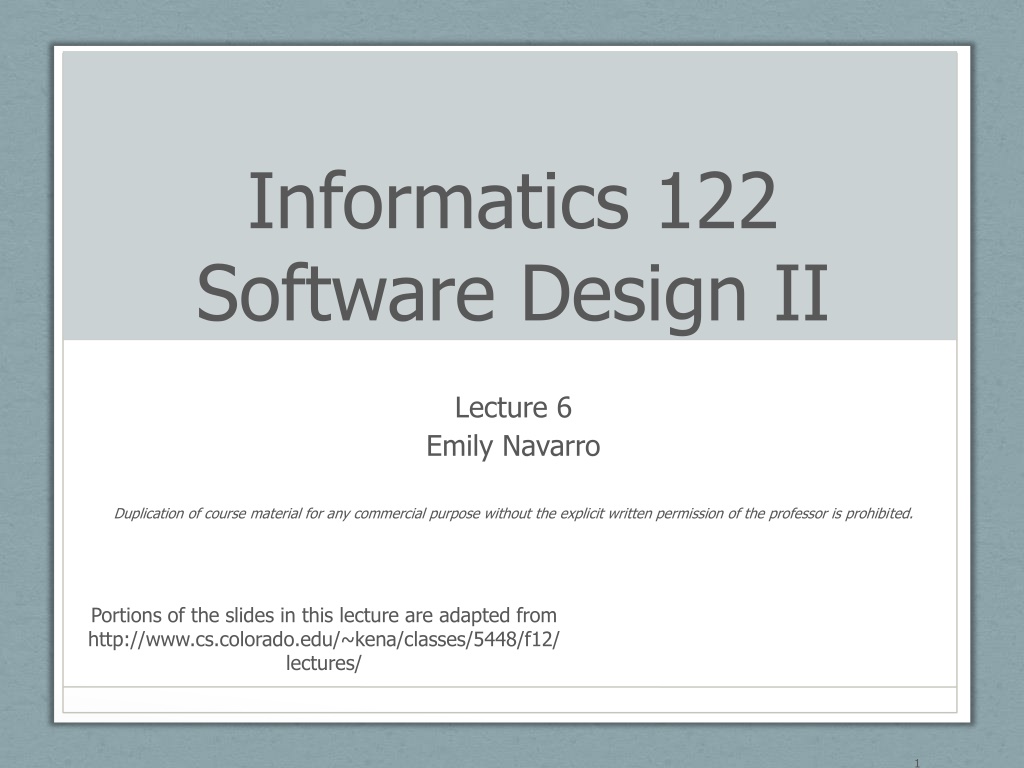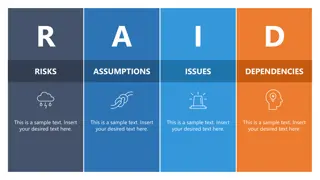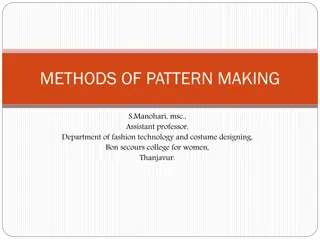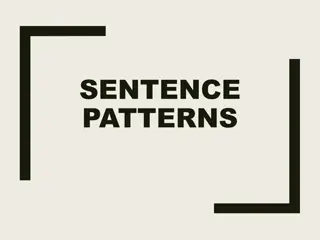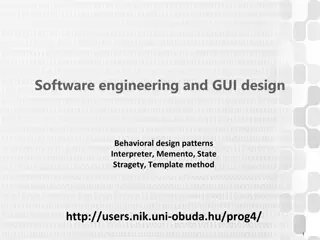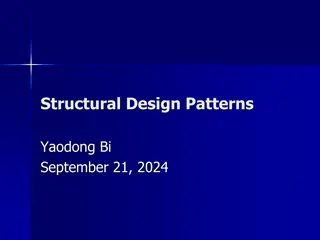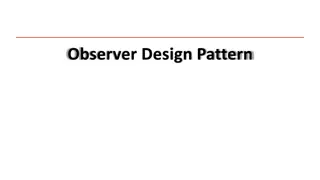Understanding Template Method Design Pattern in Software Design
Today's lecture covers the Template Method design pattern in software design, focusing on defining the pattern, its structure, and providing an example with Tea and Coffee recipes. The pattern allows subclasses to redefine certain algorithm steps without changing the overall structure, promoting code reusability and abstraction. Issues like code duplication and improving code structure are also discussed.
Download Presentation

Please find below an Image/Link to download the presentation.
The content on the website is provided AS IS for your information and personal use only. It may not be sold, licensed, or shared on other websites without obtaining consent from the author. Download presentation by click this link. If you encounter any issues during the download, it is possible that the publisher has removed the file from their server.
E N D
Presentation Transcript
Informatics 122 Software Design II Lecture 6 Emily Navarro Duplication of course material for any commercial purpose without the explicit written permission of the professor is prohibited. Portions of the slides in this lecture are adapted from http://www.cs.colorado.edu/~kena/classes/5448/f12/ lectures/ 1
Todays Lecture Design patterns part 3 of a 3-part series Three patterns: Template Method Singleton Facade Assignment 3, part 1 2
Template Method: Definition The Template Method pattern defines the skeleton of an algorithm in a method, deferring some steps to subclasses. Template Method lets subclasses redefine certain steps of an algorithm without changing the algorithm s structure Template Method defines the steps of an algorithm and allows subclasses to provide the implementation for one or more steps Makes the algorithm abstract Each step of the algorithm is represented by a method Encapsulates the details of most steps Steps (methods) handled by subclasses are declared abstract Shared steps (concrete methods) are placed in the same class that has the template method, allowing for code re-use among the various subclasses
Example: Tea and Coffee Consider an example in which we have recipes for making tea and coffee at a coffee shop Coffee Boil water Brew coffee in boiling water Pour coffee in cup Add sugar and milk Tea Boil water Steep tea in boiling water Pour tea in cup Add lemon
Code Duplication! We have code duplication occurring in these two classes boilWater() and pourInCup() are exactly the same Let s get rid of the duplication
Similar Algorithms The structure of the algorithms in prepareRecipe() is similar for Tea and Coffee We can improve our code further by making the code in prepareRecipe() more abstract brewCoffeeGrinds() and steepTea() -> brew() addSugarAndMilk() and addLemon() -> addCondiments() Now all we need to do is specify this structure in CaffeineBeverage.prepareRecipe() and make sure we do it in such a way so that subclasses can t change the structure By using the word final (see next slide)
Caffeine Beverage Implementation Note: use of final keyword for prepareRecipe() brew() and addCondiments() are abstract and must be supplied by subclasses boilWater() and pourInCup() are specified and shared across all subclasses
Coffee and Tea Implementations Nice and simple! 11
What have we done? Took two separate classes with separate but similar algorithms Noticed duplication and eliminated it by adding a superclass Made steps of algorithm more abstract and specified its structure in the superclass Thereby eliminating another implicit duplication between the two classes Revised subclasses to implement the abstract (unspecified) portions of the algorithm in a way that made sense for them
Singleton Pattern Used to ensure that only one instance of a particular class ever gets created and that there is just one (global) way to gain access to that instance Let s derive this pattern by starting with a class that has no restrictions on who can create it
Deriving Singleton (I) public class Ball { private String color; public Ball (String color) { this.color = color; } public void bounce() { System.out.println( boing! ); } } Ball b1 = new Ball ( red ); Ball b2 = new Ball ( blue ); b1.bounce(); b2.bounce();
Problem: Universal Instantiation As long as a client object knows about the name of class Ball, it can create instances of Ball Ball b1 = new Ball ( orange ); This is because the constructor is public We can stop unauthorized creation of Ball instances by making the constructor private
Deriving Singleton (II) public class Ball { private String color; private Ball(String color) { this.color = color; } public void bounce() { System.out.println ( boing! ); } } // next line now impossible by any method outside of Ball Ball b2 = new Ball ( red );
Problem: No Point of Access! Now that the constructor is private, no class can gain access to instances of Ball But our requirements were that there would be at least one way to get access to an instance of Ball We need a method to return an instance of Ball But since there is no way to get access to an instance of Ball, the method CANNOT be an instance method This means it needs to be a class method, aka a static method
Deriving Singleton public class Ball { private String color; private Ball (String color) { this.color = color; } public void bounce() { System.out.println ( boing! ); } public static Ball getInstance (String color) { return new Ball (color); } }
Problem: Back to Universal Instantiation We are back to this problem where any client can create an instance of Ball; instead of saying this: Ball b1 = new Ball ( blue ); they just say Ball b1 = Ball.getInstance ( blue ); Need to ensure only one instance is ever created Need a static variable to store that instance
Deriving Singleton (IV) public class Ball { private static Ball ball; private String color; private Ball (String color) { this.color = color; } public void bounce () { System.out.println( boing! ); } public static Ball getInstance(String color) { return ball; } }
Problem: No instance! Now the getInstance() method returns null each time it is called Need to check the static variable to see if it is null If so, create an instance Otherwise return the single instance
Deriving Singleton (V) public class Ball { private static Ball ball; private String color; private Ball (String color) { this.color = color;} public void bounce() { System.out.println( boing! ); } public static Ball getInstance (String color) { if (ball == null) { ball = new Ball(color); } return ball; } }
Problem: First Parameter Wins The code on the previous slide shows the Singleton pattern private constructor private static variable to store the single instance public static method to gain access to that instance this method creates object if needed; returns it ensures that only one instance of Ball is ever created But what if you want only one instance of each color? This code ignores the fact that a parameter is being passed in; so if a red ball is created all subsequent requests for a green ball are ignored
Solution: Use a Map The solution to the final problem is to change the private static instance variable to a Map private Map<String, Ball> ballRecord = new HashMap Then check if the map contains an instance for a given value of the parameter this ensures that only one ball of a given color is ever created this is a very acceptable variation of the Singleton pattern public static Ball getInstance(String color) { if (!ballRecord.containsKey(color)) { ballRecord.put(color, new Ball(color)); } return ballRecord.get(color); }
Singleton Pattern: Structure Singleton involves only a single class (not typically called Singleton). That class is a full-fledged class with other attributes and methods (not shown). The class has a static variable that points at a single instance of the class. The class has a private constructor (to prevent other code from instantiating the class) and a static method that provides access to the single instance.
Singleton Pattern: Real World Examples Centralized manager of resources Window manager File system manager Logger classes Factories Especially those that issue IDs Singleton is often combined with Factory Method and Abstract Factory patterns
Faade (I) Provide a unified interface to a set of interfaces in a subsystem. Fa ade defines a higher-level interface that makes the subsystem easier to use. Design Patterns, Gang of Four, 1995 There can be significant benefit in wrapping a complex subsystem with a simplified interface If you don t need the advanced functionality or fine- grained control of the former, the latter makes life easy
Faade (II) Fa ade works best when you are accessing a subset of the system s functionality You can add new features by adding them to the Fa ade (not the subsystem); you still get a simpler interface Fa ade not only reduces the number of methods you are dealing with but also the number of classes Imagine having to pull Employees out of Divisions that come from Companies that you pull from a Database A Fa ade in this situation can fetch Employees directly
Example (Without a Faade) Without a Fa ade, Client contacts the Database to retrieve Company objects. It then retrieves Division objects from them and finally gains access to Employee objects. It uses four classes.
Example (With a Faade) With a Fa ade, the Client is shielded from most of the classes. It uses the Database Fa ade to retrieve Employee objects directly.
Faade Example (I) Imagine a library of classes with a complex interface and/or complex interrelationships Home Theater System Amplifier, DvdPlayer, Projector, CdPlayer, Tuner, Screen, PopcornPopper, and TheatreLights each with its own interface and interclass dependencies
Faade Example (II) Imagine steps for watch movie turn on popper, make popcorn, dim lights, screen down, projector on, set projector to DVD, amplifier on, set amplifier to DVD, DVD on, etc. Now imagine resetting everything after the movie is done, or configuring the system to play a CD, or play a video game, etc.
Faade Example (III) For this example, we can place high level methods like watch movie , reset system , play cd in a fa ade object and encode all of the steps for each high level service in the fa ade; Demo Client code is simplified and dependencies are reduced A fa ade not only simplifies an interface, it decouples a client from a subsystem of components Indeed, Fa ade lets us encapsulate subsystems, hiding them from the rest of the system
Faade vs. Adapter Comparison (I) To many people, these two patterns (Adapter/Fa ade) appear to be similar They both act as wrappers of a preexisting class They both take an interface that we don t want and convert it to an interface that we can use With Fa ade, the intent is to simplify the existing interface With Adapter, we have a target interface that we are converting to In addition, we often want the adapter to plug into an existing framework and behave polymorphically
Faade vs. Adapter Comparison (II) Superficial difference Fa ade hides many classes Adapter hides only one But a Fa ade can simplify a single, very complex object an adapter can wrap multiple objects at once in order to access all the functionality it needs The key is simplify (fa ade) vs. convert (adapter)
More Information on Design Patterns Patterns http://en.wikipedia.org/wiki/Software_pattern http://hillside.net/patterns/patterns-catalog http://c2.com/ppr/ Interaction design patterns http://en.wikipedia.org/wiki/Interaction_design_pattern Anti-Patterns http://en.wikipedia.org/wiki/Anti-pattern#Programming_anti-patterns And numerous, numerous, numerous books and other online sources
Next Time Refactoring Assignment 3, part 2
